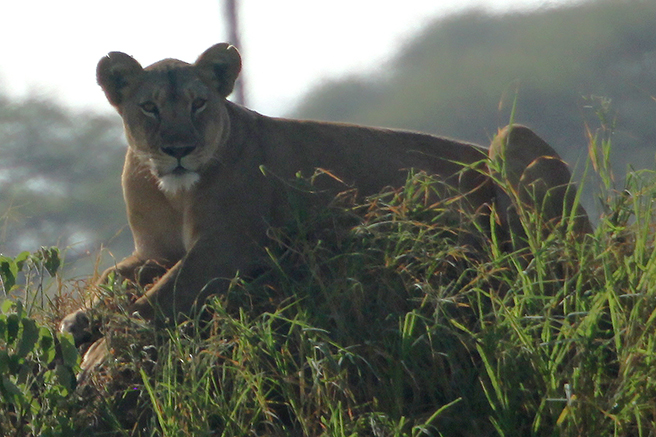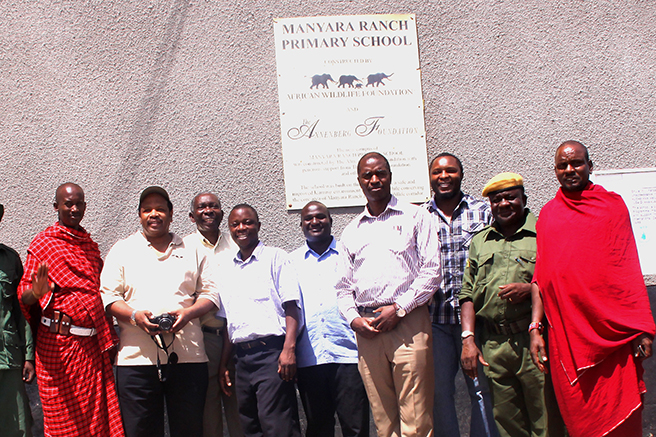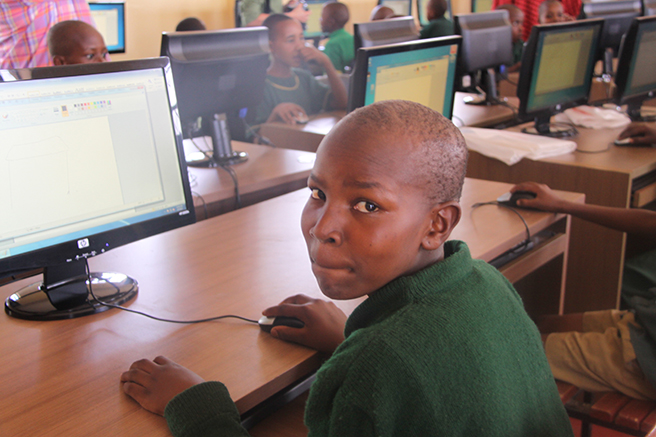A Glimpse of Manyara Ranch Primary School

Lioness in Tarangire / Photo by: Leslie Wainger
Our final “day” in Tarangire was really just a drive out of the park, then on to Manyara Ranch and the affiliated primary school, before finishing up at Gibbs Farm, a resort (the only appropriate word, if you ask me) aka eco-lodge where we would be spending the night before moving on to the Ngorongoro Crater. But honestly, there was just no such thing as making a “clean getaway” from Tarangire, because the wildlife would not be denied.
Taking the most direct route from our nyumba to the gate where we would exit the park we saw banded mongoose, zebra, ostrich, Cape buffalo, waterbuck and birds, lots and lots of birds. We saw a tawny eagle in flight, crested Francolins (which I heard as “Franklins,” like Roosevelt, LOL! – luckily my bird book saved me from embarrassment), two kinds of spurfowl – the ever-present yellow-necked and the red-necked (no wrecked pickups up on blocks in their yards, though) – yellow-collared lovebirds, the white-bellied bustard (our third kind of bustard) and more. We also saw elephants and had to wait for one herd to cross the road, because they were just not interested in the fact that we had places to go and people to see. And I don’t think any of us minded being delayed by elephants, because really…they were elephants! And we were seeing them in Africa! In the wild! (Yes, it was the kind of trip that inspired exclamation points.) Oh, and to put the capper on everything, we saw a magnificent lioness sunning herself on a rock very close to the road. Due mainly to the irresistibility of the lioness and the immovability of the elephants, ours was the last of the three Rovers to make it to the gate, where we were all meeting up to caravan to Manyara Ranch.

Manyara Ranch School Staff / Photo by: Leslie Wainger
Manyara Ranch and the Manyara Ranch Primary School are AWF projects. The ranch is a 45,000-acre corridor connecting Tarangire and Lake Manyara. Corridors like this are becoming of crucial importance all over the world, because they provide safe passage for migratory species and allow herds, prides, troupes or whatever of even relatively stationary species to intermingle, preventing genetic bottlenecks and a level of inbreeding that leads to extinction, as well as population crashes and ultimately extinction in groups that become too small to maintain a healthy breeding population.
We were met at the ranch entrance by several of the uniformed rangers who patrol the property to keep poachers out and keep an eye on the movement of the wildlife. They do important work and do it well, but I confess to being almost as impressed by their amazing sense of balance. They led the way, and three of them stood in the open back of their truck as we bounced along the usual dirt roads. Half the time they weren’t even holding on, yet no one fell, much less fell out, a feat I couldn’t have replicated in the enclosed Rovers with plenty of things to grab onto. I’m not embarrassed to say that when the going got rough, I got sitting, but not these guys. And they still kept their eyes open for the animals. Just driving through the ranch on our way to the school we saw more zebra than I could count – including a herd beautifully silhouetted against the sky – giraffe, impala, eland and a leopard tortoise that the rangers spotted as it was crossing the road. True to their calling, they stopped and carried it off to the shoulder so it could continue its journey in safety. Two of our party even saw the extremely elusive pangolin, but unfortunately I wasn’t one of them.

Student at Manyara Ranch IT Lab / Photo by: Leslie Wainger
As we drove through the ranch we passed the abandoned buildings that comprised the original primary school, which are now tumbling into decay. At some point in the relatively recent past the school was relocated from inside the ranch to outside it, both to keep the children safe from wildlife passing through and to provide amenities like power and water. It’s a private boarding school for (at the moment) just over 900 children, many of them Maasai, and over 600 of them boys. We got to meet some of the students and teachers, as well as the administrators, and though very different from an American school in some ways, it was also very familiar because, let’s face it, little kids at school all have pretty much the same wonderful mix of shyness and pride when visitors come by. There was also a large room filled with computers just like the primary schools where I live. On the other hand, unlike US schools, instead of a class having one teacher for all or most of their subjects, here there are fifteen teachers, all specialists, who move from class to class in the course of the day. The result is that around 80% of the school’s graduates go on to secondary school vs. around 10% from the public schools, and a high percentage also go on to college.